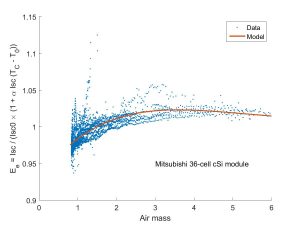Spectral mismatch models are part of the translation from broadband plane-of-array (POA) irradiance to effective irradiance. Generally, the translation takes the form
$$E_e=M\times\{IAM_B\times E_b + E_{diff}\} \times SF$$
where $$M$$ is the spectral mismatch modifier, $$IAM_B$$ is the reflection losses for the beam irradiance $$E_b$$ (i.e., $$DNI\times\cos(AOI)$$) , $$E_{diff}$$ is the diffuse POA irradiance and $$SF$$ is the soiling factor. Models for $$IAM_B$$ are found here.
Air mass model for M
A polynomial may be fit to concurrent measurements of effective irradiance and absolute air mass to model $$M$$. The polynomial model has the advantage of simplicity: air mass $$AM_a$$ can be modeled from ephemeris. However, care should be taken when applying this model outside the range of data used to fit the model.
In the SAPM, a 4th degree polynomial $$f_1(AM_a)$$ is fit to data and the coefficients are normalized so that $$f_1(AM_a = 1.5)=1$$:
$$f_1(AM_a)=\alpha_0 + \alpha_1 \times AM_a + \alpha_2 \times AM_a^2 + \alpha_3 \times AM_a^3 + \alpha_4 \times AM_a^4$$
This approach is adopted in the De soto et al. performance model , and is illustrated here for a c-Si module.

Model for M using air mass and precipitable water
An alternative model is presented by M. Lee and A. Panchula (2016), where $$M$$ is modeled using air mass and estimated precipitable water:
$$M=b_0 + b_1 \times AM_a + b_2 \times p_{wat}+ b_3 \times \sqrt{AM_a} + b_4 \times\sqrt{p_{wat}} + b_5 \times \frac {AM_a} {\sqrt{p_{wat}}}$$
where $$p_{wat}$$ is precipitable water (cm) which can be estimated from ambient temperature and relative humidity using an appropriate model (e.g., pvl_calcPwat). Coefficients for this model are found in PVLib function pvl_FSspeccorr.m.